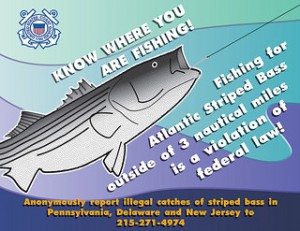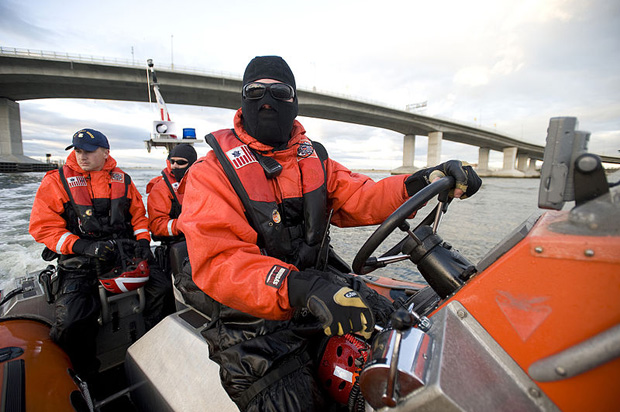By Daniel Nee November, 2014
Planning on taking your boat more than three miles offshore? If so, don’t plan on fishing for striped bass.
Though most striped bass fishing takes place close to shore and in the back bays because that is where the fish are mainly located, some anglers choose to ignore a rule that bans fishing for the species in what is known as the Exclusive Economic Zone, or EEZ, defined as any distance between three and 200 nautical miles from shore. An uptick in poaching has led the Coast Guard to plan stepped up enforcement of the ban, officials said.
 “It’s important to remember Atlantic striped bass have not fully recovered from years of overfishing,” said Capt. Kathy Moore, the commander of Coast Guard Sector Delaware Bay in Philadelphia, which is responsible for the waters off the New Jersey coast from Shark River Inlet to Cape May. “Complying with these rules will ensure this resource is available to future generations.”
“It’s important to remember Atlantic striped bass have not fully recovered from years of overfishing,” said Capt. Kathy Moore, the commander of Coast Guard Sector Delaware Bay in Philadelphia, which is responsible for the waters off the New Jersey coast from Shark River Inlet to Cape May. “Complying with these rules will ensure this resource is available to future generations.”
The intensified poaching patrols will take place all winter long off the New Jersey and Delaware coasts, according to a statement from Coast Guard Public Affairs Detachment Atlantic City.
A person caught fishing for, or in possession of striped bass while in the EEZ is subject to civil fines.
In New Jersey’s back bays and ocean waters within the three nautical mile limit, anglers are allowed to keep two fish at a minimum size of 28 inches. At a meeting of the state Marine Fisheries Council last week, with no closed season in the ocean; back bay fishing is allowed March 1 to Dec. 31.
The regulations will change for 2015 thanks to a decision by the Atlantic States Marine Fisheries Commission – the federal body which lays out fishing quotas to state regulatory agencies – that the recreational striped bass catch must be reduced by 25 percent.
As for poaching, the public is being encouraged by the Coast Guard to report any suspected poaching activity to Coast Guard Sector Delaware Bay at 215-271-4974. Calls should include a description of the activity, those involved, the location and the time of the suspected offense. Such information greatly increases the effectiveness of law enforcement operations.
Go to site…






